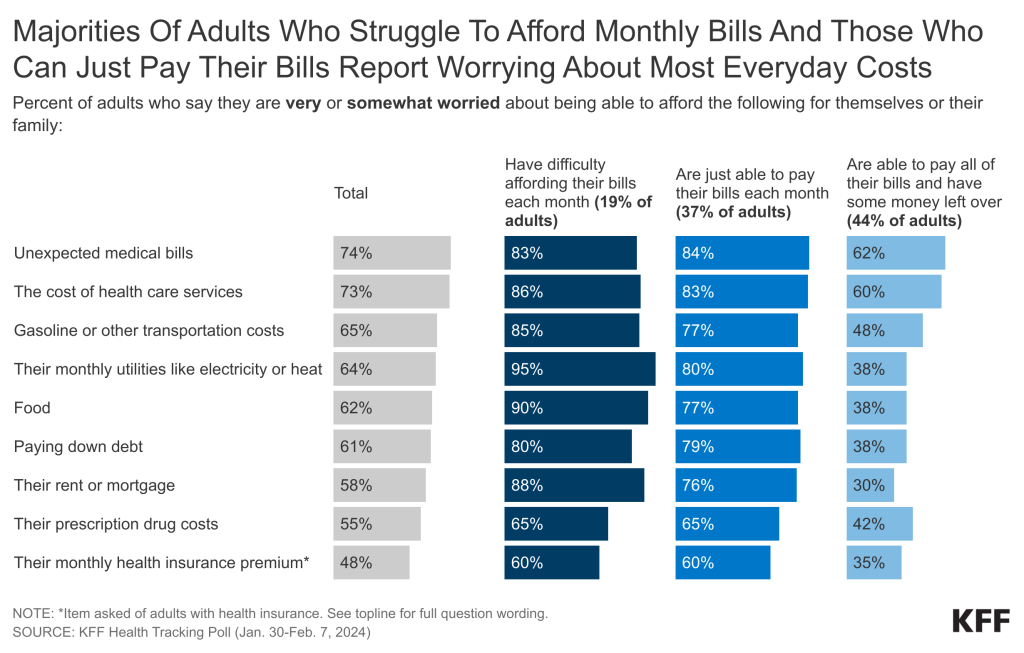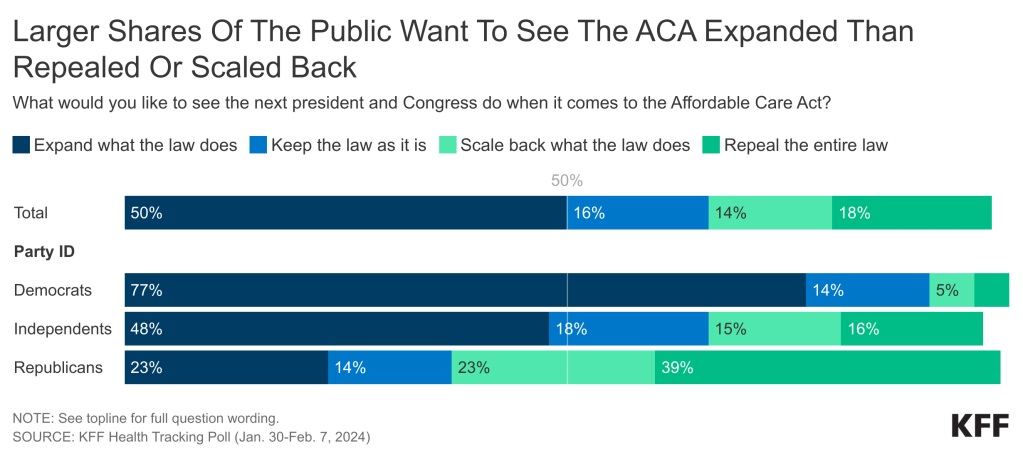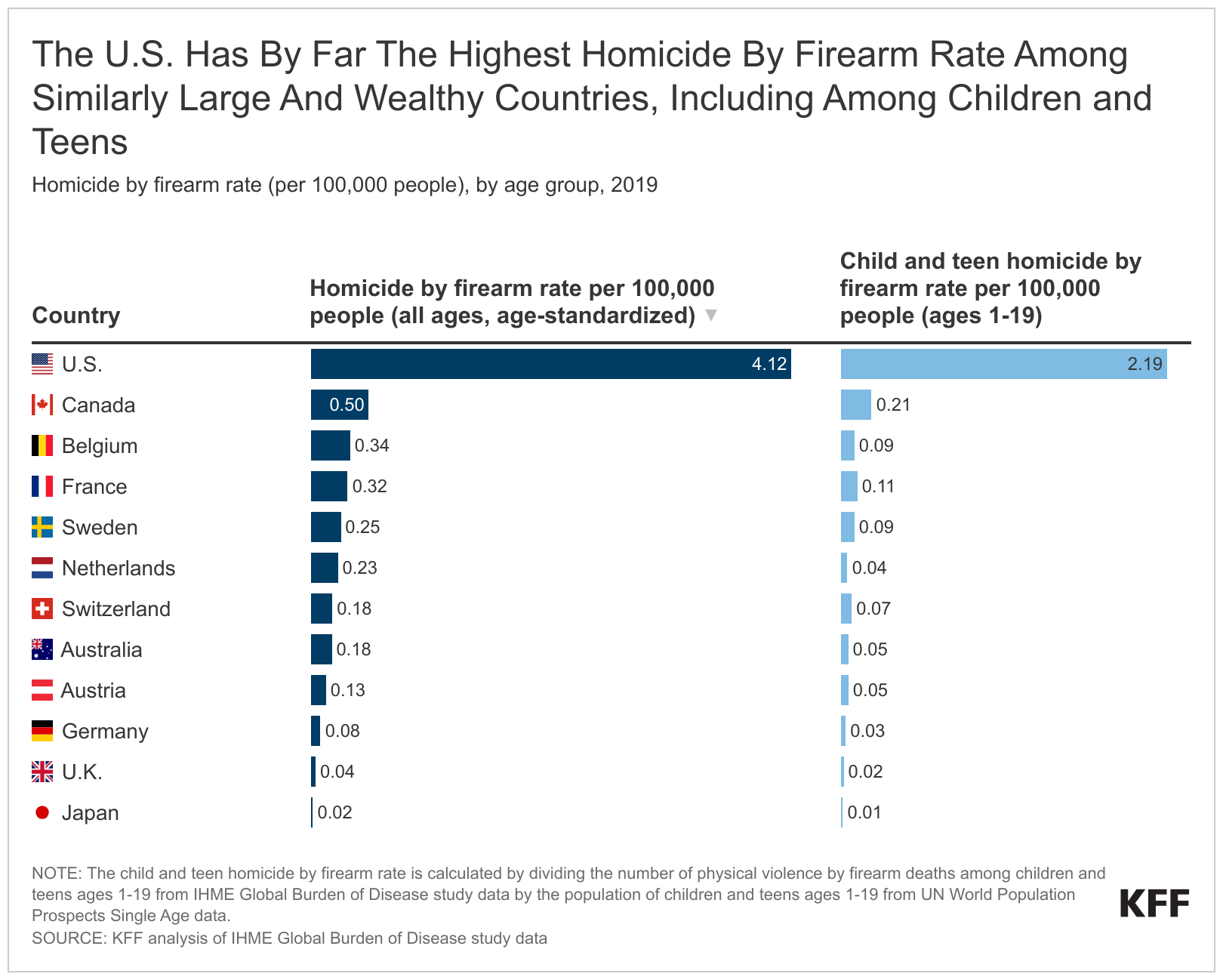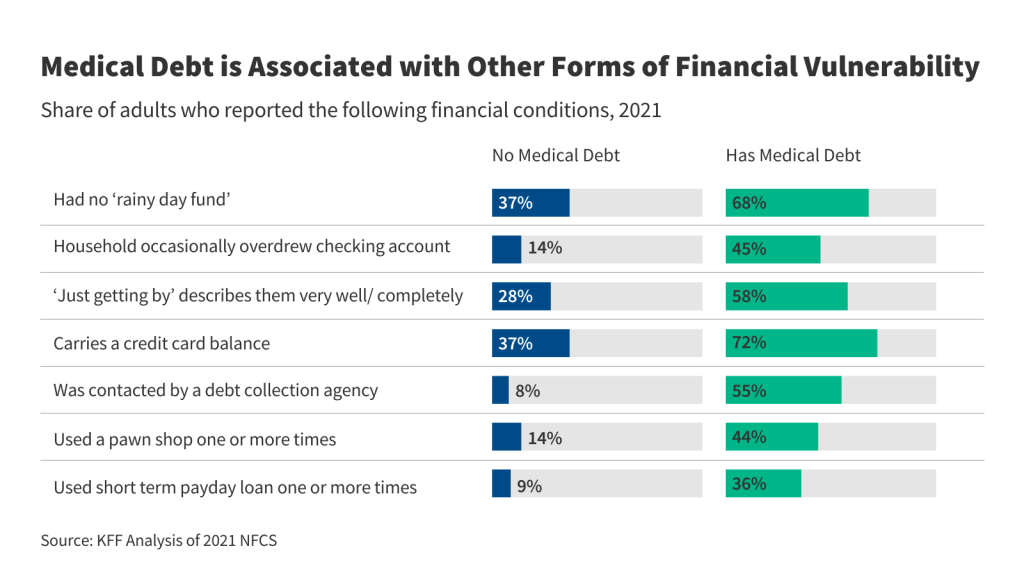KFF Health Tracking Poll February 2024: Voters on Two Key Health Care Issues: Affordability and ACA
Findings
Key Takeaways
- Inflation and health care affordability continue to be the top issues voters want the 2024 presidential candidates to talk about on the campaign trail, and while national news has recently emphasized an improving national economy alongside expanded consumer spending, most voters (67%) rate the national economy as “not so good” or “poor.” Voters’ assessment of the economy is largely influenced by their perceptions of their own costs, as majorities describe the economy negatively due to the cost of everyday expenses (64%), inflation (63%), the cost of housing (57%), or the cost of health care (48%). About half of all voters say the economy is “not so good” or “poor” due to the state of the federal budget deficit and national debt (52%), and few say financial indicators such as the unemployment rate (24%) or the state of the stock market (20%) factor into their assessment in a major way.
- Unexpected medical bills and health care costs top the list of expenses that adults, regardless of partisanship, say they worry about affording, with three in four adults saying they are “very” or “somewhat worried” about being able to afford unexpected medical bills (74%) or the cost of health care services (73%) for themselves and their family. Just over half (55%) report worrying about being able to afford prescription drug costs, and about half of insured adults (48%) say they are worried about being able to afford their monthly health insurance premium.
- Voters are divided along party lines over which candidate they think has the better approach to the future of the Affordable Care Act, with partisans overwhelmingly choosing their party’s candidate. Nine in ten Democratic voters (90%) say Biden has the better approach and nine in ten Republican voters (91%) say Trump does. Although the vast majority of Republicans say Trump has a better approach to the ACA, few (30%) Republican voters think Trump has a health care plan to replace it. At the same time, most of the public does not associate President Biden with playing a major role in the passage of the ACA, which was signed into law when he was Vice President. One in five (21%) say he had a major role in the law’s passage, including a larger share of Democrats ages 50 and older (42%).
- The Affordable Care Act continues to be more popular than it was prior to Republican attempts to repeal it in 2017, with six in ten (59%) expressing a favorable view, though partisans are divided on what they want to see done with the law. About three in four Democrats want the next Presidential Administration and Congress to expand what the law does (77%), while about two-thirds of Republicans either want the law to be scaled back (23%) or repealed entirely (39%). A majority of independents want the law to be expanded (48%) or kept as is (18%).
- One of the most consistently popular provisions of the Affordable Care Act is its protections for people with pre-existing conditions. Most adults across partisans say it is very important that the aspects of the law that prevent health insurance companies from denying coverage due to someone’s medical history (67%) and that prevent health insurance companies from charging sick people higher premiums (65%) remain law. However, few – between three and four in ten for each aspect – are aware that these are provisions of the ACA.
- Knowledge among the public is low regarding the Affordable Care Act’s impact on lowering the rate of uninsured in the U.S. and the all-time high rate of enrollees during the recent open enrollment period. One-third (35%) of adults – rising to about half (48%) of Democrats – correctly say that since the ACA was passed in 2010, the uninsured rate in the U.S. has decreased. A similar share (34%) correctly say that more people signed up in this enrollment period than in the past.
Health Care Affordability as a Voting Issue
Voters want to Hear from Candidates on Inflation, The Affordability of Health Care and The Future of Government Health Care Programs
Heading into the election, the issues that voters are most interested to hear candidates talk about are related to the economy and health care costs. At least eight in ten voters say it is “very important” for the 2024 presidential candidates to talk about inflation (83%) and the affordability of health care (80%) – relatively unchanged from November 2023. Following inflation and health care affordability, about seven in ten voters say it is “very important” to hear presidential candidates talk about the future of Medicare (73%), the future of democracy (72%), and immigration (69%).
The future of the Affordable Care Act, an issue that was once a key health care issue for Republican voters, is ranked as a “very important” issue for larger shares of Democratic voters (71%) than Republican voters (36%). In December 2023, former President Donald Trump reignited the issue by announcing that he plans to replace the 2010 health care law. However, similar minorities of Republicans now and before these statements say the issue is “very important” to them.
With inflation and health care affordability remaining among the most important issues voters want to hear the presidential candidates talk about heading into the 2024 election, two-thirds of voters (67%) describe the national economy as either “not so good” or “poor.” Republican voters are more than twice as likely as Democrats to rate the economy negatively (88% v. 37%) and seven in ten independent voters (72%) rate the economy negatively.
Large shares of voters who rate the economy negatively cite cost issues, including health care costs, as a major reason for doing so. A majority of voters rate the economy negatively and say a “major reason” for doing so is the cost of everyday expenses (64%), inflation (63%), or the cost of housing (57%). About half of voters describe the economy as “not so good” or “poor” and say the state of the federal budget deficit and national debt (52%) or health care costs (48%) are a “major reason” for their negative views. Far fewer voters cite indicators such as the unemployment rate (24%) or the state of the stock market (20%) as a “major reason” they rate the economy negatively.
Among those who rate the economy negatively, Democratic voters are more likely than Republican voters to cite the cost of health care and the rate of unemployment as “major reason” for doing so, while Republican voters are more likely to cite the state of the federal budget deficit and national debt.
Health Care Expenses Top List of Financial Worries
Alongside voters’ overwhelmingly negative views of the economy, large shares of the public say they worry about being able to afford basic living expenses with health care cost concerns topping the list. About three in four adults say they are either “very” or “somewhat worried” about being able to afford unexpected medical bills (74%) or the cost of health care services (73%) for themselves and their families. Just over half of adults (55%) say they are “very worried” about being able to afford prescription drug costs, and about half of insured adults say they are “very” or “somewhat worried” about being able to afford their monthly health insurance premium (48%).
Beyond health care cost concerns, a majority of the public reports worrying about being able to afford gasoline or other transportation costs (65%), their monthly utilities like electricity and heat (64%), food (62%), paying down debt (61%), or their rent or mortgage (58%). About four in ten parents (43%) say they are worried about being able to afford child care for themselves and their family.
Unexpected medical bills and the cost of health care services are the top financial worries across partisans. At least seven in ten Democrats and Republicans say they are “very” or “somewhat worried” about being able to afford the cost of health care services (72% and 75%, respectively) or unexpected medical bills (71% and 78%, respectively) for themselves and their family.
Biden vs. Trump on Addressing High Health Care Costs
With health care affordability topping the list of issues voters want to hear about and leading the list of financial worries, the latest KFF Tracking Poll suggests neither President Biden nor former President Trump has a clear advantage on this issue, but Republicans give Trump higher marks on this issue than Democrats give Biden.
Reflecting the current dynamic of the 2024 election overall, voters are divided along partisan lines on which candidate did more when they were president to address health care costs. Most Democrats (90%) say Biden has done more to address health care costs and most Republicans (91%) say Trump did more during his time as president. Independents are split, with similar shares saying each did more to address health care costs.
While partisans say their party’s candidate did more to address health care costs, Trump receives higher levels of satisfaction on the issue from voters overall and Republican voters than Biden does from voters overall and Democratic voters. One in seven (14%) voters overall say Biden has done more than Trump and has done enough to address health care costs, while one in four (26%) say Trump has done more than Biden and that he did enough on this issue. A majority of voters say neither president did enough, including about one in three who say President Biden did more than Trump but not enough (36%) and about one in five who say former President Trump did more than Biden but not enough (22%). Trump may be reaping the benefits of the retrospective views of voters, whereas criticism of Biden may be more reflective of voters’ general dissatisfaction with the current state of the national economy.
This also holds true when examining partisan attitudes, with Democratic voters being less satisfied with Biden’s performance than Republican voters are with Trump on health care costs: About one in three (33%) Democratic voters say Biden has done enough to address health care costs while six in ten (59%) Republican voters say Trump has done enough. Few independent voters are satisfied with either candidate’s addressing of health care costs, as one in ten (9%) say President Biden has done enough and 14% say former President Trump has done enough. This is in-line with Democrats’ overall lack of enthusiasm of President Biden and strong support for Trump among Republicans as each party’s respective presidential candidate at this time.
Perhaps reflecting younger voters’ overall lower enthusiasm for President Biden, one in four (24%) younger Democratic voters say Biden has done enough when it comes to addressing health care costs, compared to four in ten (40%) Democratic voters ages 50 and older who say the same.
Republican voters, however, by age are aligned, with similar shares across age groups saying Trump has done enough to address health care costs. Trump may be reaping the benefits of the retrospective views of a largely Republican base, whereas Democrats’ critiques of President Biden may reflect voters’ general dissatisfaction with the current state of the economy.
The Affordable Care Act as a Voting Issue
In November of last year, former President Trump reignited the conversation of replacing the Affordable Care Act if elected president, an issue that was once a key health care issue for Republicans. Once a more contentious issue, the health care law enacted under the Obama Administration in 2010 has consistently garnered more support than opposition since 2018.
However, views of the Affordable Care Act remain partisan with nearly nine in ten (87%) Democrats and about half (55%) of independents holding positive views of the law while two-thirds (67%) of Republicans view the law unfavorably. One-third (33%) of Republicans view the law favorably, a share that has increased since the law was enacted. See here for full trend on views of the ACA by partisanship.
Building on the ACA has been a focal point of President Biden’s health care agenda, while former President Trump has recently discussed his desire to try again to repeal and replace the law. Half of the public say they would like to see the next president and Congress expand what the ACA does. A smaller share wants to keep the law as it is (16%) and about a third want to either scale back what the law does (14%) or repeal it entirely (18%). Partisans differ on these approaches, with about three in four Democrats wanting the 2024 incoming administration and Congress to expand what the law does (77%), while two-thirds of Republicans want the law to be scaled back (23%) or repealed entirely (39%). A majority of independents want the law to be expanded (48%) or kept as it is (18%). Views towards what to do with the health care law have remained largely unchanged since 2020.
Views of the ACA may be driven by interactions with the law and perceptions about what it has done for access to health insurance. About four in ten (39%), including similar shares across household income, say the Affordable Care Act has made it easier for people like them to get health insurance, while about one quarter (23%) say it has made it more difficult and about one-third (37%) say it has had no impact on people like them to get health insurance. Similar to other assessments of the 2010 health care law, this perception varies by partisanship, as Democrats are about three times as likely as Republicans (60% v. 22%) to say the ACA has helped people like them get insurance. More than four in ten independents (44%) say the ACA has had no impact on the ability of people like them to get health insurance.
Similar shares of adults under and over age 65 – the age of eligibility for Medicare, a government health insurance program – say the ACA has made it easier for people like them to get health insurance (40% among adults ages 18 to 64 vs. 36% among adults ages 65 and older), though younger adults are more likely to say the ACA has made it more difficult for them to access health care (25% v. 17%) and less likely to say it has had “no impact” on people like them (34% v. 45%).
The passing of the Affordable Care Act under the Obama Administration was one of Biden’s achievements as Vice President, and its expansion became a cornerstone for his 2020 presidential campaign and administration, but many voters do not associate Biden with the ACA. About half of adults associate President Biden with the passing of the Affordable Care Act, with one in five saying he had a major role (21%) and about three in ten (28%) saying he had a “minor role” in the passing of the legislation. Few (14%) say he had no role, and about four in ten (38%) are not sure. About one third (32%) of Democrats say that Biden had a “major role” in the passing of the ACA, including larger shares of Democrats ages 50 and older (42%) than younger Democrats (23%). About one in five (22%) Republicans say that Biden had a major role, including similar shares across age groups. About one third of partisans say they are not sure about Biden’s role in the ACA.
Biden vs. Trump on the Affordable Care Act
Voters are split along party lines in their assessments of the potential 2024 presidential candidates’ approaches to the ACA, with about nine in ten Democratic voters saying they think President Biden has the better approach to determining the future of the ACA, and similar shares of Republicans saying the same of Trump. Independent voters are split, with half (50%) saying Biden has the better approach and about half (47%) saying Trump has the better approach. Neither President Biden nor former President Trump has the edge among voters overall when it comes to approaches to determining the future of the Affordable Care Act.
While Republican voters think President Trump has a better approach to determining the future of the ACA, many say they either don’t think he has a health care plan to replace the 2010 law or are unsure. A majority of voters, including seven in ten Republican voters, say they do not think President Trump has a health care plan to replace the ACA (42%) or that they are not sure if he has a plan (43%). Trump’s supporters, or MAGA Republican voters, are most likely to say Mr. Trump does have a plan, with one-third (35%) saying this compared to one in seven (16%) non-MAGA Republicans.
Pre-Existing Conditions Protections
As part of the ACA, private health insurance companies are prohibited from denying coverage based on a person’s medical history and are prohibited from charging those with pre-existing conditions more coverage. These protections have been consistently popular among the public, and about two-thirds of adults say it is “very important” that provisions prohibiting insurance companies from denying coverage because of a person’s medical history (67%) and prohibiting insurance companies from charging sick people more (65%) remain law.
Pre-existing condition provisions are popular across party lines. For example, about eight in ten (79%) Democrats and two-thirds (66%) of independents say it is “very important” to them that the provision prohibiting health insurance companies from denying coverage because of one’s medical history remains intact. A slight majority (54%) of Republicans say this is “very important” to them, and an additional third (35%) say it is “somewhat important.” Similarly, half (51%) of Republicans and majorities of Democrats (79%) and independents (65%) say it is “very important” that insurance companies are prohibited from charging sick people more.
Although the future of the Affordable Care Act has reentered the news cycle with Trump’s reigniting of repeal efforts, awareness of the law’s provisions is low. About three in ten (31%) adults are aware that the ACA prohibits private health insurance companies from charging sick people higher premiums, while about seven in ten say they are not sure or incorrectly say it does not, though Democrats (37%) are more likely than Republicans (29%) to correctly say it does. Six in ten adults either say they are not sure or do not know if the ACA prohibits private health insurance companies from denying coverage for a pre-existing condition, including similar shares across partisans.
Knowledge of the law’s provisions has dropped over the past 14 years. At its height, seven in ten U.S. adults were aware of the ACA’s protections for people with pre-existing conditions at the law’s inception in 2010. Since 2017, fewer than half of U.S. adults have been aware, while the popularity of these provisions remains high.
The ACA Marketplace
Since 2010, with the enactment of the Affordable Care Act Marketplaces and expansion of Medicaid, the share of uninsured non-elderly adults in the U.S. has dropped from 18% to about 10%. About one in three (35%) are aware of this decrease – rising to half (48%) of Democrats – while about three in ten adults say the uninsured rate has increased (32%) or remained the same (31%) since 2010. Republicans (39%) are more likely than Democrats to say the uninsured rate has stayed the same.
During the open enrollment period at the end of 2023, a record breaking number of individuals selected health insurance plans through the ACA Marketplace, or healthcare.gov, continuing a trend of increases in enrollment since 2020’s open enrollment period. However, this fact is not widely known among the public: one in three (34%) U.S. adults correctly say more people purchased their own health insurance through the Affordable Care Act Marketplace during this enrollment period than in past years, while about one in five (23%) say fewer people signed up, and four in ten (40%) say about the same number of enrollees signed up. There are sharp partisan divides on knowledge of the latest enrollment period, as half of Democrats correctly say more people signed up, compared to one in four Republicans who say the same.
Methods
This KFF Health Tracking Poll was designed and analyzed by public opinion researchers at KFF. The survey was conducted January 30 – February 7, 2024, online and by telephone among a nationally representative sample of 1,309 U.S. adults in English (1,231) and in Spanish (78). The sample includes 1,026 adults (n=58 in Spanish) reached through the SSRS Opinion Panel either online (n=1,002) or over the phone (n=24). The SSRS Opinion Panel is a nationally representative probability-based panel where panel members are recruited randomly in one of two ways: (a) Through invitations mailed to respondents randomly sampled from an Address-Based Sample (ABS) provided by Marketing Systems Groups (MSG) through the U.S. Postal Service’s Computerized Delivery Sequence (CDS); (b) from a dual-frame random digit dial (RDD) sample provided by MSG. For the online panel component, invitations were sent to panel members by email followed by up to three reminder emails.
Another 283 (n=20 in Spanish) interviews were conducted from a random digit dial telephone sample of prepaid cell phone numbers obtained through MSG. Phone numbers used for the prepaid cell phone component were randomly generated from a cell phone sampling frame with disproportionate stratification aimed at reaching Hispanic and non-Hispanic Black respondents. Stratification was based on incidence of the race/ethnicity groups within each frame.
Respondents in the phone samples received a $15 incentive via a check received by mail, and web respondents received a $5 electronic gift card incentive (some harder-to-reach groups received a $10 electronic gift card). In order to ensure data quality, cases were removed if they failed attention check questions in the online version of the questionnaire, or if they had over 30% item non-response, or had a length less than one quarter of the mean length by mode. Based on this criterion, one case was removed.
The combined cell phone and panel samples were weighted to match the sample’s demographics to the national U.S. adult population based on parameters derived from the Census Bureau’s 2022 Current Population Survey (CPS), 2021 Volunteering and Civic Life Supplement data from the CPS, and the 2023 KFF Benchmarking survey with ABS and prepaid cell phone samples. The demographic variables included in weighting for the general population sample are sex, age, education, race/ethnicity, region, education, civic engagement, internet use, and political party identification by race/ethnicity. The sample of registered voters was weighted separately to match the U.S. registered voter population using the parameters above plus recalled vote in the 2020 presidential election by county quintiles grouped by Trump vote share. Both weights account for differences in the probability of selection for each sample type (prepaid cell phone and panel). This includes adjustment for the sample design and geographic stratification of the cell phone sample, within household probability of selection, and the design of the panel-recruitment procedure.
The margin of sampling error including the design effect for the full sample and registered voters is plus or minus 4 percentage points. Numbers of respondents and margins of sampling error for key subgroups are shown in the table below. For results based on other subgroups, the margin of sampling error may be higher. Sample sizes and margins of sampling error for other subgroups are available by request. Sampling error is only one of many potential sources of error and there may be other unmeasured error in this or any other public opinion poll. KFF public opinion and survey research is a charter member of the Transparency Initiative of the American Association for Public Opinion Research.
| Group | N (unweighted) | M.O.S.E. |
| Total | 1,309 | ± 4 percentage points |
| Total Registered Voters | 1,055 | ± 4 percentage points |
| Republican Registered Voters | 343 | ± 7 percentage points |
| Democratic Registered Voters | 368 | ± 7 percentage points |
| Independent Registered Voters | 241 | ± 8 percentage points |
































